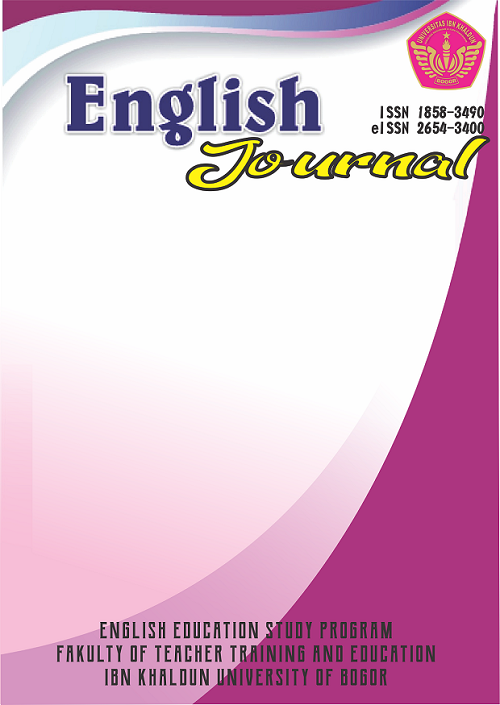STUDENT WELLBEING INDEX AND ITS INFLUENCING FACTORS IN AN ENGLISH EDUCATION PROGRAM
DOI:
https://doi.org/10.32832/english.v16i2.8262Abstract
Wellbeing is undoubtedly important in education and has become the focus of program orientation in some institution. As a hidden curriculum, all lecturers should apply their own techniques to promote student wellbeing. This study is trying to identify the index of students' wellbeing and the influencing factors. There were 34 students as the participants of the study. The data was taken by distributing questionnaire and conducting an interview. The result showed that student wellbeing index reached 75.5, under good category. There are two factors that constitute student wellbeing; the supporting factors and the obstacle factors. The supporting factors identified are lecturers, study program, friends, and future career. The obstacle factors are online learning, student-self competences, and assignment or material. This study recommended the institution to maintain and improve student wellbeing index by promoting explicit design of wellbeing teaching learning process in its curriculum.
References
Aulia, Farah. ( 2018). Improving Student Wellbeing at School. PROCEEDING of Conference of Mental Health, Neuroscience, and Cyberpsychology. DOI: https://doi.org/10.32698/25275.
Alexandrova, A., 2017. A Philosophy for the Science of Well-being. Oxford: Oxford University Press
Batubara, Febti Mahani, Tatum Derin, Nunung Susilo Putri, Ratih Slatri Yudar. (2020). Five Factors Influencing the Students' Motivation to Learn English as a Foreign Language: A Closer Look into Montessori Classroom Environment. Journal of Research and Innovation in Language. Vol. 2, No. 2, Agustus2020, pp. 76-84. Retrieved from: https://journal.unilak.ac.id/index.php/REILA/article/view/3165/2286
Benjamin, Daniel J. (2015). How should we measure wellbeing. Retrieved from https://www.weforum.org/agenda/2015/01/how-should-we-measure- wellbeing-2/
Bernice I. Neugarten, Ph.D., R J Havighurst, S S Tobin (1961) The Measurement of Life Satisfaction. Retrieved from https://doi.org/10.1093/geronj/16.2.134
Borualogo, Ihsana Sabriani , & Ferran Casas. (2019) Adaptation and Validation of The Children's Worlds Subjective Well-Being Scale (CW-SWBS) in Indonesia. Jurnal Psikologi . Volume 46, Nomor 2, 102 – 116 . DOI: 10.22146/jpsi.38995 https://jurnal.ugm.ac.id/jpsi32-44. http://dx.doi.org/10.4018/IJCBPL.2019100103
Cohen, J. (2006). Social, emotional, ethical and academic education: Creating a climate for learning, participation in democracy and well-being. Harvard Educational Review, Vol. 76, No. 2, Summer, pg 201-237.
Collings, V. Swanson and R. Watkins. (2014). The impact of peer mentoring on levels of student wellbeing, integration and retention: a controlled comparative evaluation of residential students in UK higher education. Higher Education , December 2014, Vol. 68, No. 6 (December 2014), pp. 927-942 Published by: Springer. https://www.jstor.org/stable/43648763
Garringer, Michael & MacRae, Patti. (2008). Building Effective Peer Mentoring Programs in Schools: An Introductory Guide. Retrieved from https://educationnorthwest.org/sites/default/files/building-effective-peer- mentoring-programs-intro-guide.pdf
Huebner, E.S. (1994) Preliminary Development and Validation of a Multidimensional Life Satisfaction Scale for Children. Psychological Assessment, 6, 149-158. http://dx.doi.org/10.1037/1040- 3590.6.2.149
Lynch, Timothy. ( 2019). Physical Education and Wellbeing: Global and Holistic Approach to Child Health. Switzerland: Palgrave Macmillan.
Lyubomirsky, S., & Layous, K. (2013). How do simple positive activities increase well-being? Current directions in psychological science. 22(1), 57-62. DOI: https://doi.org/10.1177/0963721412469809
MacIntyre, Peter D., Tammy Gregersen, Sarah Mercer. (2020). Language teacherscoping strategies during the Covid-19 conversion to online teaching: Correlations with stress, wellbeing and negative emotions. System. https://doi.org/10.1016/j.system.2020.102352
Martin, S.E.P . (2012) Flourish: A Visionary New Understanding of Happiness and Well-being. Atria books. https://www.amazon.com/Martin-E-P- Seligman/e/B001ILOB78/ref=dp_byline_cont_pop_book_1
Mashford-Scott, A., Church, A., & Tayler, C. (2012). Seeking Children's Perspectives on their Wellbeing in Early Childhood Settings. International Journal of Early Childhood, 44, 231-247.
McLennan, Nancy and Ms Jannine Thompson.. (2015). Quality Physical Education (QPE): guidelines for policy makers. France: UNESCO
Noble, T., & McGrath, H. (2008). The positive educational practices framework: A tool for facilitating the work of educational psychologists in promoting pupil wellbeing. Educational and Child Psychology, 25(2), 119–134.
Robeyns, Ingrid. (2020). Wellbeing, Place and Technology. Wellbeing, Space and Society. 1. 100013. 10.1016/j.wss.2020.100013
Scott, Angela Mashford-, Amelia Church, Collette Tayler. (2012). Seeking Children's Perspectives on their Wellbeing in Early Childhood Settings. International Journal of Early Childhood volume 44, pages231–247 (2012)
Susanti dkk. (2021). Pembelajaran Paradigma Baru. Jakarta: Pusat Asesmen dan Pembelajaran Badan Penelitian dan Pengembangan dan Perbukuan Kementerian Pendidikan, Kebudayaan, Riset, dan Teknologi.

















1.png)




